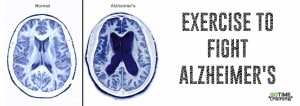
What is Alzheimer’s?
Alzheimer’s is the most common form of dementia, a general term for memory loss and other cognitive abilities serious enough to interfere with daily life. Alzheimer’s disease accounts for 60 to 80 percent of dementia cases. Mostly in adults over 65, but Alzheimer’s is not just a disease of old age. Approximately 200,000 Americans under the age of 65 have younger-onset Alzheimer’s disease (also known as early-onset Alzheimer’s)
What I don’t need to tell you is, Alzheimer’s is terrible disease.
As my father is 74 it’s a possible reality that I think about way too often. No one wants to go through that with their loves ones and of course for themselves.
Sadly, as of now, there currently is no cure for Alzheimer’s, but…
Did You know?
Exercise may prevent Alzheimer’s disease! Studies show that people who are physically active are less likely to experience a decline in their mental function and have a lowered risk of developing Alzheimer’s disease and now research shows it works as a great therapy, as well.
This is fantastic news! Thanks to new scientific studies, we are discovering exercise can be great for prevention and treatment.
Vigorous exercise not only makes Alzheimer’s patients feel better, but it makes changes in the brain that could indicate improvements.
“Regular aerobic exercise could be a fountain of youth for the brain,” said Laura Baker of the Wake Forest School of Medicine, who led one of the studies on exercise and Alzheimer’s.
Baker worked with 70 patients with mild cognitive impairment, which can lead to Alzheimer’s, and diabetes, which can raise the risk.
Her team assigned them to work out at community facilities, doing either supervised aerobics – usually on a treadmill – or stretching for 45 minutes to an hour, four times a week.
Over the six months of the study, the researchers tested verbal recall, decision-making, looked at spinal fluid and blood, and did MRI brain scans.
Levels of tau, a protein associated with Alzheimer’s, fell in those who exercised vigorously, Baker told the conference. Exercisers had better blood flow in the memory and processing centers of their brains and had measurable improvement in attention, planning, and organizing abilities referred to as executive function.
“These findings are important because they strongly suggest a potent lifestyle intervention such as aerobic exercise can impact Alzheimer’s-related changes in the brain,” Baker said in a statement. “No currently approved medication can rival these effects.”
It fits in with a study that found two years of exercising, eating healthier food and brain training can boost people’s memory function.
In a second study, Dr. Steen Hasselbalch of the University of Copenhagen in Denmark and colleagues randomly assigned 200 Alzheimer’s patients to either do an hour of vigorous exercise three times a week or continue their normal lives for four months.
As with Baker’s group, they got people up to 70 to 80 percent of maximum heart rate for at least half of each session. That’s what most experts consider vigorous exercise.
They used a test of thinking and memory called the Symbol-Digit Modalities test and checked symptoms of depression, activities of daily living and quality of life.
The exercisers had far less anxiety, irritability, and depression than those who didn’t work out. Those who exercised the most and the hardest scored significantly better on the Symbol-Digit Modalities test.
So, with knowing the benefits from these promising studies about Alzheimer’s prevent and treatment through exercise…
What should we do?
Special Considerations
People with Alzheimer commonly have a higher level of restlessness or agitation at the end of the day, which experts have labeled “sundowning.” This increased state of agitation, activity, and negative behaviors is associated with high levels of fatigue and tiredness later in the day. Therefore, the exercise program should be scheduled for an earlier time in the day, preferably in the morning, when the client’s agitation level is usually at its lowest and mental cognition is at its highest.
If the client is exercising at home with a family member, a daily walk may be the optimal way to establish a beginning structured routine. Resistance training will be a benefit, but, as the disease progresses, walking may be the only exercise the individual can carry out; and once ambulation is no longer a possibility, because of either the inability to walk or the risk of wandering, maintenance of range of motion becomes crucial.
The hallmark exercise program is one that keeps a person active at various times during the day (e.g., 10 min exercise routines), poses a low risk of injury from falls, and has a strong behavioral component (e.g., effective reinforcement strategies).
Alzheimer’s Disease: Exercise Programming
- Modes – Aerobic:
- Enjoyable activities involving large muscle groups and familiar activities
- Goals:
- Increase functional health (i.e., maintaining ability to perform various activities and instrumental activities of daily living)
- Increase endurance necessary for community ambulation
- Intensity/Frequency/Duration:
- Monitor HR or RPE
- 40-60 min/session (may be broken up into smaller 15-20 min activities throughout the day)
- Time to goal:
- Emphasize enjoyment rather than performance improvements.
- Increase duration by adding daily activities that require exercise (e.g., walking to the mail box or gardening).
Mobility Training:
- Take all joint through full range of motion.
- Strengthen core muscles
Strength Training:
- Strengthen postural muscles.
- Focus on areas of weakness (i.e., quadriceps, hip extensors).
- Use 10 to 12 reps or less as tolerated.
Aerobic Training: Walking and Chair Aerobic Exercises
- Emphasize enjoyment.
- Maintain function.
Flexibility Training:
- Stretch postural muscle groups.
Focus on exercises that can be done on a raised platform (i.e., mat table) or chair; getting down or up from the floor may be difficult



